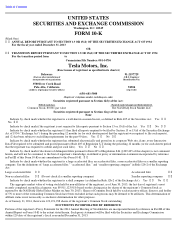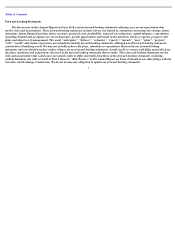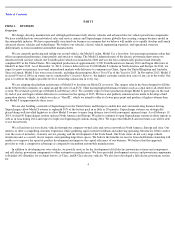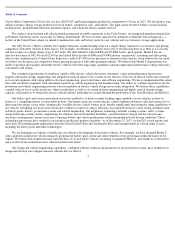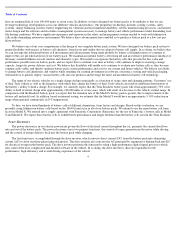Tesla 2014 Annual Report Download - page 10
Download and view the complete annual report
Please find page 10 of the 2014 Tesla annual report below. You can navigate through the pages in the report by either clicking on the pages listed below, or by using the keyword search tool below to find specific information within the annual report.
Table of Contents
have an estimated life of over 100,000 miles or seven years. In addition, we have designed our battery packs to be modular so that we can
leverage technology developments across our different vehicles and products. Our proprietary technology includes cooling systems, safety
systems, charge balancing systems, battery engineering for vibration and environmental durability, robotic manufacturing processes, customized
motor design and the software and electronics management systems necessary to manage battery and vehicle performance under demanding real-
life driving conditions. We have significant experience and expertise in the safety and management systems needed to work with lithium-ion
cells in the demanding automotive environment. We believe these advancements have enabled us to produce a battery pack at a low cost per
kilowatt-hour.
We believe one of our core competencies is the design of our complete battery pack system. We have designed our battery pack system to
permit flexibility with respect to battery cell chemistry, form factor and vendor that we adopt for battery cell supply. In so doing, we believe that
we can leverage the substantial battery cell investments and advancements being made globally by battery cell manufacturers to continue to
improve the cost per kilowatt-
hour of our battery pack. We maintain an internal battery cell testing lab and an extensive performance database of
the many available lithium-ion cell vendors and chemistry types. We intend to incorporate the battery cells that provide the best value and
performance possible into our battery packs, and we expect this to continue over time as battery cells continue to improve in energy storage
capacity, longevity, power delivery and cost. We believe this flexibility will enable us to continue to evaluate new battery cells as they become
commercially viable, and thereby optimize battery pack system performance and cost for our current and future vehicles. We believe our ability
to change battery cell chemistries and vendors while retaining our existing investments in software, electronics, testing and vehicle packaging,
will enable us to quickly deploy various battery cells into our products and leverage the latest advancements in battery cell technology.
The range of our electric vehicles on a single charge declines principally as a function of usage, time and charging patterns. Customers’
use
of their Tesla vehicle as well as the frequency with which they charge the battery of their Tesla vehicle can result in additional deterioration of
the battery’s ability to hold a charge. For example, we currently expect that the Tesla Roadster battery pack will retain approximately 70% of its
ability to hold its initial charge after approximately 100,000 miles or seven years, which will result in a decrease to the vehicle’s initial range. In
comparison with the Roadster battery pack, we expect that the retention rate of the Model S battery pack is greater, due to improvements at the
battery cell and pack level. In addition, based on internal testing, we estimate that the Model S would have an approximate 5-10% reduction in
range when operated continuously in 0°C temperatures.
To date, we have tested hundreds of battery cells of different chemistries, form factors and designs. Based on this evaluation, we are
presently using lithium-ion battery cells based on the 18650 form factor in all of our battery packs. We intend to use the same battery cell form
factor in Model X. We entered into a supply agreement with Panasonic Corporation (Panasonic) for the use of Panasonic’
s battery cells in Model
S and Model X. We expect these battery cells to exhibit better performance and longer lifetimes than the battery cells used in the Tesla Roadster.
Power Electronics
The power electronics in our electric powertrain govern the flow of electrical current throughout the car, primarily the current that flows
into and out of the battery pack. The power electronics have two primary functions, the control of torque generation in the motor while driving
and the control of energy delivery back into the battery pack while charging.
The first function is accomplished through the drive inverter, which converts direct current (DC) from the battery pack into alternating
current (AC) to drive our three-phase induction motors. The drive inverter also converts the AC generated by regenerative braking back into DC
for electrical storage in the battery pack. The drive inverter performs this function by using a high-performance digital signal processor which
runs some of the most complicated and detailed software in the vehicle. In so doing, the drive inverter is directly responsible for the
performance, high efficiency and overall driving experience of the vehicle.
9


